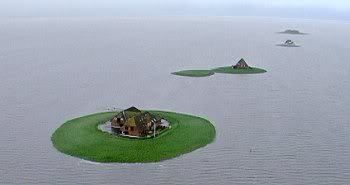 | ||
Similar | ||
The Halligen (singular Hallig) are ten small German islands without protective dikes in the North Frisian Islands on Schleswig-Holstein's Wadden Sea-North Sea coast in the district of Nordfriesland.
Contents
Map of Die Halligen, 25859 Hooge, Germany
The name comes from a Celtic word hal, meaning "salt", a reference to the low-lying land in the region which is often flooded over with saltwater by the tides. A greater number of Halligen existed in the Middle Ages than in the 21st century. The very existence of the Halligen is a result of frequent floods and poor coastal protection. The floods were much more common in the Middle Ages and coastal protection was much poorer. A look at the maps on this page will demonstrate that this part of the North Sea coast is very much at the sea's mercy.
The Halligen have areas ranging from 7 to 956 ha, and are often former parts of the mainland, separated therefrom by storm tide erosion. Some are also parts of once much bigger islands sundered by the same forces. Sometimes, owing to sediment deposition, islands have actually grown together to form larger ones. Langeneß (or Langeness) includes a former island by that same name, and two others that were called Nordmarsch and Butwehl.
Dwellings and commercial buildings are built upon metre-high, man-made mounds, called Warften in German, to guard against storm tides. Some Halligen also have overflow dikes.
Not very many people live on the Halligen. Their livelihoods are mainly based on tourism, coastal protection, and agriculture. This last activity mainly involves raising cattle in the fertile, often flooded, salt meadows.
The Halligen are to be found in the Schleswig-Holsteinisches Wattenmeer National Park. The commercially developed Halligen Nordstrandischmoor, Gröde, Oland, Langeneß, and Hooge are surrounded by the protected area, but not an integral part of it. The smaller Halligen Habel, Südfall, Süderoog, and Norderoog as well as the Hamburger Hallig are parts of the national park. Walks on the tidal flats and informational meetings are offered by tourist boards and the park administration.
In the west the German Halligen are protected from the open sea by the North Frisian Barrier Island.
The island of Mandø in the Danish part of the archipelago is also technically one of the Halligen, although it is far away from the other ten, which are quite near each other. Mandø can be reached from the mainland over the mudflats at low tide, when a tidal pathway (ebbevej in Danish, meaning "ebb-way") is above water.
List of Halligen
Currently, there are 10 halligen in Germany. The following list does not include formerly existing Halligen that have either vanished or merged with current halligen or the mainland:
On the Danish side, three Halligen are to be noted, current or past:
The peninsula and former island of Großer Werder on the Baltic Sea coast is also nicknamed "Baltic Hallig" (Ostsee-Hallig) due to its remote situation and appearance.
